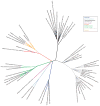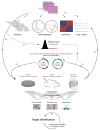Advances in sarcoma genomics and new therapeutic targets
- PMID: 21753790
- PMCID: PMC3361898
- DOI: 10.1038/nrc3087
Advances in sarcoma genomics and new therapeutic targets
Erratum in
- Nat Rev Cancer. 2011;11(9):685
Abstract
Increasingly, human mesenchymal malignancies are being classified by the abnormalities that drive their pathogenesis. Although many of these aberrations are highly prevalent within particular sarcoma subtypes, few are currently targeted therapeutically. Indeed, most subtypes of sarcoma are still treated with traditional therapeutic modalities, and in many cases sarcomas are resistant to adjuvant therapies. In this Review, we discuss the core molecular determinants of sarcomagenesis and emphasize the emerging genomic and functional genetic approaches that, coupled with novel therapeutic strategies, have the potential to transform the care of patients with sarcoma.
Conflict of interest statement
The authors declare no competing financial interests.
Figures




References
-
- Fletcher C, Unni K, Mertens F. Pathology and genetics of tumors of soft tissue and bone. International Agency for Research on Cancer Press; Lyon: 2002.
-
- Jemal A, Siegel R, Xu J, Ward E. Cancer statistics, 2010. CA Cancer J Clin. 2010;60:277–300. - PubMed
-
- Borden EC, et al. Soft tissue sarcomas of adults: state of the translational science. Clin Cancer Res. 2003;9:1941–56. - PubMed
-
- Helman LJ, Meltzer P. Mechanisms of sarcoma development. Nat Rev Cancer. 2003;3:685–94. - PubMed
-
- Mertens F, et al. Translocation-related sarcomas. Semin Oncol. 2009;36:312–23. - PubMed
Publication types
MeSH terms
Substances
Grants and funding
LinkOut - more resources
Full Text Sources
Other Literature Sources
Medical
Molecular Biology Databases

